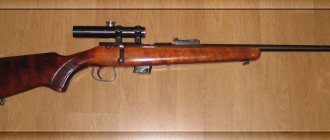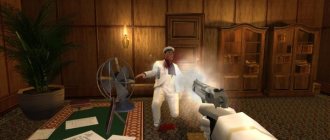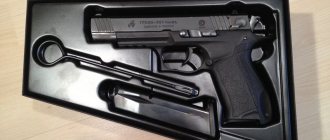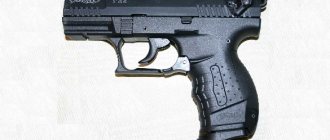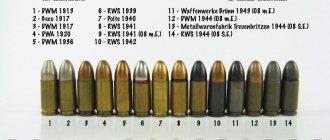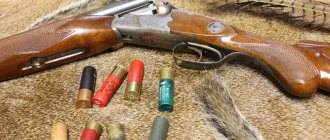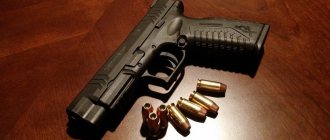Description
IZH-79-8 was created on the basis of a combat analogue (Makarov pistol). The main components and mechanisms are structurally practically no different from the original. The working elements of the trigger mechanism and frame are made of weapons-grade steel, which is not often found in the design of gas pistols. The “beard” is practically absent, the shutter is lightweight, the impulse of the charge used is quite enough to throw the shutter back.
The thin barrel is equipped with a pressed-in bushing, which increases the pressure when firing a salvo and makes it impossible to modify the barrel for a combat charge. There are cuts on the outer part of the breech; the fastening of the barrel to the frame is weakened. This is done so that when fired with a live cartridge, the structure simply shatters into pieces. Thanks to reinforced materials, the weapon in question is superior to many domestic and foreign analogues in reliability and durability. The export version is supplied to Europe for the popular 8*20 mm ammunition.
Buy 8 mm blank cartridges in the store
Our online store offers customers a wide range of 8 mm blank cartridges, which anyone can buy without a license in accordance with the current legislation of the Russian Federation. We offer products of exclusively the highest quality - the fame and authority of the companies that produced these 8 mm blank cartridges cannot be disputed. If you are the owner of any gas or traumatic weapon of the stated caliber, then these, which you can buy in Moscow in our online store, will be an ideal addition to the standard ammunition.
The trade offers the buyer a large selection of gas pistols, revolvers, cartridges for them, as well as self-defense means in aerosol packaging (gas cans) of both domestic and foreign production. It is not easy for a buyer who is far from weapons problems to navigate among such diversity. The situation is aggravated by the impossibility of fully checking the operation of the product when purchasing it and the lack of information available to the consumer about the mandatory requirements for gas weapons.
Numerous publications about gas weapons are scattered, contradictory, or represent hidden or overt advertising that significantly exaggerates the merits of a particular product. There is a need for a qualified analysis of issues related to various aspects of the circulation of this type of weapon, taking into account the requirements of the Russian Federation Laws “On Weapons” and “On the Protection of Consumer Rights,” state standards and mandatory certification requirements. This is especially important due to the fact that some of the weapons sold are still not certified or certified with significant violations.
Incomplete disassembly
The IZH-79-8 gas pistol is subject to complete or partial disassembly. The first option is appropriate only in case of severe contamination after exposure to rain or snow, as well as for repairs. Partial disassembly is carried out as follows:
- The magazine is removed from the base of the handle by retracting the latch all the way. The chamber is inspected by lowering the flag, moving the bolt to the rear extreme position, setting the delay and inspecting the chamber for the presence of ammunition.
- The shutter is separated from the frame. To do this, pull the trigger guard, move it to the right and press it against the frame so that it locks in this position. The bolt is then moved to its rearmost position and lifted by the rear end until it moves forward under the influence of a spring mechanism. The shutter separates.
- The return spring is removed from the barrel.
Assembly of IZH-79-8 is carried out in the reverse order.
Design
The Nambu cartridge has a bottle-shaped sleeve made of steel or brass, clad with copper. The sleeve had a groove for the ejector and a small lip.
Design of the 8x22 mm Nambu cartridge
The cartridge's jacketed bullet was made of copper, steel (copper-plated) or brass. The bullet weight is from 6.4 to 7 g, and the powder charge is 0.23 g. The total weight of the cartridge is 10.2 g.
The 8x22 mm cartridge is found under different names:
- 8 mm Nambu Selbstlade Pistole,
- 8 mm "Japanese",
- 8 mm "Japanese Nambu",
- 8 mm "Nambu M.1914",
- 8 mm "Type 14",
- "EB 095"
- "SAA 3745"
Complete disassembly
This operation begins with the partial disassembly procedures described above. Then do the following:
- Unscrew the handle screw and remove it from the frame.
- The bolt and the mainspring itself will appear. After moving the valve down, the spring mechanism can be easily removed.
- Using an awl, pry the edge of the sear spring from the bolt stop. Then the sear is rotated in the trunnions until it is easily separated from the pistol and dismantled along with the bolt delay.
- The trigger is tilted forward and removed from the seat.
- At the finishing stage, the trigger rod and hook, as well as the cocking lever, are dismantled.
At this point, the complete disassembly of the pistol in question can be considered complete.
Advantages and disadvantages
Due to the fact that the bullet has subsonic speed, a pistol with a silencer chambered for the Nambu cartridge was widely used by many European and American states, as well as by gangster groups.
Various Nambu cartridges
In addition, shooting with Nambu cartridges was quite comfortable, and the recoil was extremely low.
Another undoubted advantage of the Nambu cartridge is that it provided high accuracy and accuracy of fire.
Various Nambu cartridges
As for the disadvantages of this cartridge, there are more than enough of them:
- the cartridge has low penetration and penetrating ability, as well as a weak stopping effect. In this regard, it is extremely similar to the cartridge for the Nagan revolver mod. 1895;
- 8 x 22 mm Nambu has a rather short firing range. For a pistol it is 25-50 m, and for a submachine gun - 75-100 m.
Nambu Ammo Box
Gas cartridges 8 mm
These ammunition are used as a means of active self-defense in the event of a real threat to life or health. The charges are used to mentally suppress the aggressor without causing him serious injury or damage. Inside the gas cartridge is equipped with a capsule with a red lid. The reservoir is filled with the active active substance (pelargonic acid morpholide). This mixture causes tearing and irritates the mucous membrane of the respiratory organs.
Performance characteristics (using the example of a Teren-3 cartridge):
- Caliber – 8 mm.
- Length/diameter – 20/8 mm.
- Weight – 3 g.
- Contents: boxes of 50 pcs.
- Set weight – 153 g.
Use of 8 mm blank cartridges
8mm blank cartridges are an exact copy of the original and are made from the same materials as the real thing. The only difference in their design is the absence of a ballistic projectile (); instead, the end of the cartridge is closed with a plastic cap, which is completely destroyed during a blank shot.
The characteristics of 8 mm noise cartridges, which can be purchased without a license from us, are standard for all products of this type. The length of the sleeve is 20.1 millimeters, the total weight of each cartridge is 3.14 grams.
8 mm signal cartridges are excellent for equipping numerous models of gas and traumatic pistols, popular all over the world. Considering the prevalence of these types of weapons and their widespread availability, 8 mm noise cartridges are a very popular and popular product.
The main scope of application of these products is for the self-defense of private users (the acoustic effect repels intruders and animals). They are also widely used during leisure time, as an absolutely safe analogue of real cartridges.
Application
8 mm gas cartridges of this type are effective at a distance of up to 3 meters. Due to the design features of most pistols that use this ammunition, the weapon is used primarily without long-term aiming, “offhand.”
To acquire the skills of conducting effective fire, training is necessary, during which the weight of the pistol, gusts of wind, and other factors should be taken into account. This will help not only to accurately hit the target, but also to avoid some of the gas from hitting your side. It is worth emphasizing that the chamber and barrel of the IZH-79-8 pistol must be cleaned and lubricated after use. The same applies to the processing of weapons after long-term storage. Proper maintenance and care not only extend the service life of the gun, but also protect it from cartridge jamming.
Firing with the charges in question is prohibited if the distance to a person is less than one meter from the muzzle. The possibility of using cartridges with mechanical, corrosion defects, or after the expiration date is also excluded. Optimal conditions for storing such cartridges are temperatures from -20 to +40 degrees with a humidity not exceeding 90%.
Cartridge 8×50 R / 8 mm Lebel
| 8×50 R Lebel Balle M, M 1886 D, M 1932 N, M 1917 T, M 1915 P (from left to right) |
The 8×50 R caliber cartridge may have the following designations: 8 mm.
Lebel / 8.03×51 R / 8×50.5 R / 8.03×50 R / 8 mm Lebel Modelo 1886 / DWM 472 / DWM 472A / 80x50R Mod. 86-88-93-1932 / SAA 4105 / XCR 08 050 BBC 060. “Balle M” bullet
The 8×50 R cartridge was developed by the French - Captain Desalliers and Colonel Gras in 1886 for the Lebel rifle.
The new cartridge was based on the 11-mm Gra cartridge, whose bullet diameter was simply reduced to 8 mm, hence the strongly conical shape of the cartridge case.
The bullet was fastened by crimping the barrel into a groove on the bullet.
8x50 R Lebel
The 8x50 R cartridge was sometimes designated as 8x51 R to distinguish it from the 8x50 R Mannlicher ammunition.
Until 1898, the cartridge had a bullet with a rounded tip weighing 15 grams. (bullet "Balle M").
Then a pointed bullet developed by Desalliers (the "M 1886 D" bullet) was introduced. The bullet was entirely made of bronze.
After inserting a pointed bullet, a radial groove was made in the bottom of the cartridge case so that in the tubular magazine of the Lebel rifle the bullet would not stick into the capsule of the cartridge located in front of it.
In 1917, a bullet with a lead core and a copper-nickel jacket was introduced; the bullet length was 32 mm and weighed 12.6 grams.
In 1923, the “M 1923 C” bullet appeared with a steel jacket coated with nickel and copper, 35.2 mm long and weighing 12.6 grams.
In 1932, a bullet appeared that was similar in appearance to the “D” bullet, but with a lead core and a copper-nickel jacket (the “M 1932 N” bullet); the circumference of the capsule of such cartridges was black, purple or green.
The cartridge was used by the armies of countries friendly to France in Asia and Africa. After the occupation by Germany (during the First World War) of France, it was actively used on all fronts.
In 1941, the people's militia near Moscow were often armed with Lebel rifles and Hotchkiss machine guns chambered for this cartridge, left over from the First World War.
bullets of the 8×50 R Lebel M 1886 D, M 1932 N, M 1917 T, M 1915 P cartridge (from left to right)
At the end of the 1960s, production of the cartridge was discontinued.
Types of bullets for the 8×50 R cartridge:
— bullet “M 1886 D” with grooves – a cartridge with a reduced charge for use in automatic weapons; — bullet “M 1886 D” – all-metal – bronze; — incendiary bullet “Type Patriot” model 1914-1916, similar in appearance to the “Balle M” bullet, but longer and contains white phosphorus; — armor-piercing bullet “M 1915 P”, weight 9.6 g; — tracer bullet “M 1917 T” – is a galvanized bullet “D” with a tracer in the bottom; — bullet “M 1932 N” with a lead core.
In various modifications, the weight of the 8×50 R cartridge was 2b.7-30.3 g; bullet weight - 9.6-15.1 g; charge weight - 3.0 g; cartridge length - 60.0-74.9 mm.
